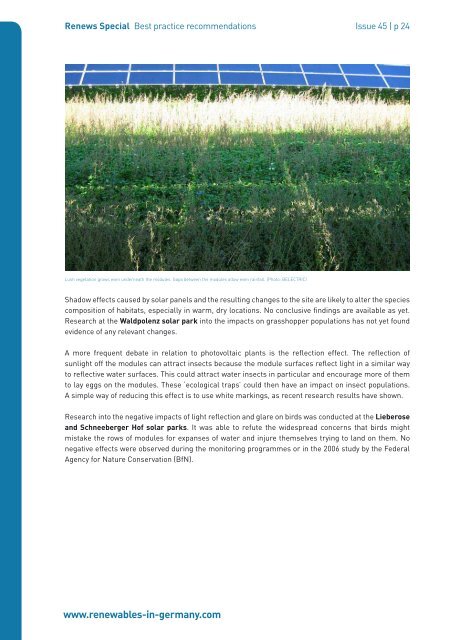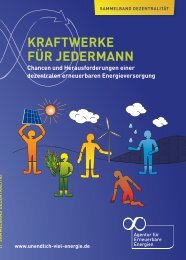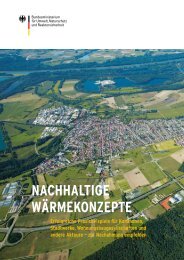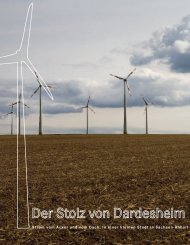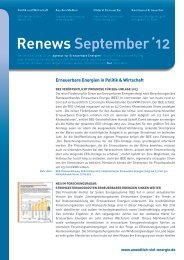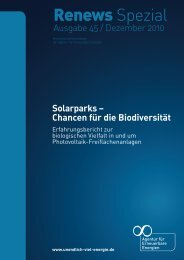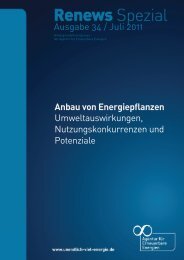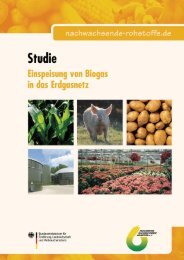Solar parks - Agentur für Erneuerbare Energien
Solar parks - Agentur für Erneuerbare Energien
Solar parks - Agentur für Erneuerbare Energien
You also want an ePaper? Increase the reach of your titles
YUMPU automatically turns print PDFs into web optimized ePapers that Google loves.
Renews Special Best practice recommendations Issue 45 | p 24 p 25 | Issue 45 Renews Special <strong>Solar</strong> <strong>parks</strong> – Opportunities for Biodiversity<br />
Lush vegetation grows even underneath the modules. Gaps between the modules allow even rainfall. (Photo: BELECTRIC)<br />
Shadow effects caused by solar panels and the resulting changes to the site are likely to alter the species<br />
composition of habitats, especially in warm, dry locations. No conclusive findings are available as yet.<br />
Research at the Waldpolenz solar park into the impacts on grasshopper populations has not yet found<br />
evidence of any relevant changes.<br />
A more frequent debate in relation to photovoltaic plants is the reflection effect. The reflection of<br />
sunlight off the modules can attract insects because the module surfaces reflect light in a similar way<br />
to reflective water surfaces. This could attract water insects in particular and encourage more of them<br />
to lay eggs on the modules. These ‘ecological traps’ could then have an impact on insect populations.<br />
A simple way of reducing this effect is to use white markings, as recent research results have shown.<br />
Research into the negative impacts of light reflection and glare on birds was conducted at the Lieberose<br />
and Schneeberger Hof solar <strong>parks</strong>. It was able to refute the widespread concerns that birds might<br />
mistake the rows of modules for expanses of water and injure themselves trying to land on them. No<br />
negative effects were observed during the monitoring programmes or in the 2006 study by the Federal<br />
Agency for Nature Conservation (BfN).<br />
d. Helping conserve the regional genetic diversity of plants<br />
Compensatory measures are often carried out during the erection of solar <strong>parks</strong>. For example, shrubs<br />
are often planted to provide ground cover, while seed mixtures are sown on open areas. The genetic<br />
biodiversity can be affected by the choice of plant used for the various purposes.<br />
<strong>Solar</strong> <strong>parks</strong> can become flourishing landscapes. Selecting the right seed promotes conservation of the regional genetic diversity of plants. (Photo: Gehrlicher <strong>Solar</strong> AG)<br />
When creating ground cover for solar <strong>parks</strong> in the open countryside, one should do more than just make<br />
sure that the selected plants are suitable for the site, i.e. that the environmental requirements of the<br />
plant match the site characteristics. By using native seeds and plants that are suitable for the site and<br />
that have been obtained from within a defined source region, it is possible to make a valuable contribution<br />
to the conservation and promotion of regional genetic diversity. Depending on the project objectives, it<br />
may be desirable to leave an area unsown. If it is left to form its own ground cover, species will establish<br />
themselves over the years. This type of ground cover can be encouraged by sowing hayflowers (Flores<br />
graminis) or by spreading suitable grass cuttings containing seeds. For hayflowers one spreads what is<br />
left on the ground where hay has been stored, which contains seeds as well as the hay remnants.<br />
Conserving the regional genetic diversity of plants<br />
Certified, native seeds and plants should be used when developing solar <strong>parks</strong>. Further information<br />
is available from the German Association of Wild Seed and Plant Producers (VWW) at<br />
www.natur-im-vww.de and from the Association for the Promotion of Native Shrubs and Trees in<br />
Brandenburg (www.gebietsheimische-gehoelze.de).


